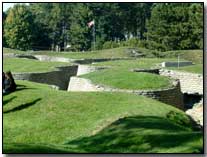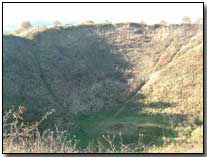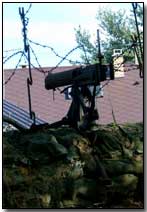Feature Articles - In Search of the Horbury Soldiers
 Horbury is a small town in
West Yorkshire, on the outskirts of Wakefield.
Horbury is a small town in
West Yorkshire, on the outskirts of Wakefield.
In 1914 when war was first declared one hundred and fifty men joined up. This isn't a large figure but Horbury is only a small town. The men that joined up were normal everyday men who gave up their jobs as blacksmiths, grocers and iron workers to join the war effort and fight for King and country.
Most of the men who joined up believed that the war would be over before Christmas and that it would be a nice holiday trip over to France. This was the attitude that a lot of men had, hence the large numbers of young men that joined up. Out of the men that left Horbury many did not return.
Horbury School has been making visits to the First World War sites for over eighteen years. The trip always attracts a lot of attention and many students want to go. I feel that I have been privileged to take part in two of the trips and as well as finding the trips a source of knowledge I have been moved to tears on both occasions.
We were taken on the trip by two amazing historians both of whom have a great amount of knowledge and experience on the subject. This was the twentieth trip for one of the teachers and he knew the fields like the back of his hand, showing us many things that you would not find yourself. We were retracing the steps that one hundred of Horbury's sons had taken over eighty years before.
We arrived in France and headed out into the Somme.
We planned to find thirty eight of the men who died for the so-called "cause". Out of these thirty eight only seven had graves - the rest were on memorials dotted around France and Belgium.
 The
main places where the men of Horbury are buried are
Thiepval,
Tyne Cot
and the
Menin Gate. We were to
visit all of these in detail and spend time to find all of the men and where
they are remembered. The fact that only seven of the men we were to go
find had graves was shocking as the rest could be buried anywhere.
This upset a lot of people.
The
main places where the men of Horbury are buried are
Thiepval,
Tyne Cot
and the
Menin Gate. We were to
visit all of these in detail and spend time to find all of the men and where
they are remembered. The fact that only seven of the men we were to go
find had graves was shocking as the rest could be buried anywhere.
This upset a lot of people.
The first soldier that we went to pay our respects to was T. Wilson at Ovillers Military Cemetery. T. Wilson was killed in action on the twenty fourth of August 1918. This was the first cemetery that we had seen in France and we thought it was huge. The thought that all of the people who had died in here were killed was a horrible thought. The men in here had not lived most of their lives but had been cut down before they could flourish. Who could let anything like this happen?
We had located our first soldier and were now in search for the second. Our search didn't take long, in fact, only a short drive down the road to Blighty Valley. Like Ovillers, Blighty Valley is a reasonably small cemetery. Some of the men at Ovillers were actually killed at Blighty valley but had to be moved up to Ovillers as there was fighting still at Blighty Valley.
Blighty Valley only holds one of Horbury Men, a Thomas Walpole. Thomas was in the Kings Own Yorkshire Light Infantry. This was where most of the Horbury Soldiers were placed. Thomas Walpole died on the first day of the Somme, the first of July 1916.
The next of the Horbury men is buried at Lonsdale Cemetery. G.W. Talbot is unlike any of the Horbury soldiers. Most of the men were in their late teens or early twenties. G.W. Talbot died on the 7th of September 1916, aged thirty. Like most of the men he was part of the Kings Own Yorkshire Light Infantry.
Three more men are also buried on the Somme battlefields. We did not visit these men. These are W. Littleton who is buried at Longueval. Cecil Mellor and W. Lassey who are both buried at Beaumont Hamel at the Ancre British Cemetery.
 These
were all of the graves that we were to see with the names of Horbury's
soldiers on. This was a bit depressing as out of all of the people
that died from Horbury only seven of them have graves.
These
were all of the graves that we were to see with the names of Horbury's
soldiers on. This was a bit depressing as out of all of the people
that died from Horbury only seven of them have graves.
The same day we visited Thiepval monument. This is a huge monument and we could see it before we were anywhere near it. Thiepval was built in 1927 and originally had the names of 73,367 who died on the Somme. The total now is more like 72,000 as some people have been found. Many are probably buried in a cemetery but couldn't be identified so a headstone saying "known unto God" was erected.
The Thiepval Memorial is holds the names of all the people who died on the Somme and have no known grave. This does not include the huge amount of men who died and who do have known graves. Only a small walk down the road is the Mill Road Cemetery, near the Ulster Tower.
On the Thiepval memorial are the names of fourteen men from Horbury who were killed on the Somme. These complete the names of all of the men who died from Horbury and who died on the Somme.
While at the Somme we visited other places such as Lochnagar crater, Delville Wood, Fricourt, Pozieres and many more.
On our way up to Ypres we stopped at Vimy Ridge to see the memorial and the preserved tunnels and trenches. Vimy Ridge is an important part of Canadian military history because it was the Canadians who finally took the ridge after unsuccessful attempts by the English and the French.
The Canadians started the offensive on the 9th of April 1917. Four Victoria Crosses were given out to the Canadians for the capture of Vimy Ridge. I found out the following information at the museum at Vimy Ridge:
Private William Milne of the 16th Battalion won the VC when he crawled up to a German machine-gun that had been firing on the advancing Canadians, bombed its crew and captured the gun. Later, he stalked a second machine-gun, killing its crew and capturing it, but was himself killed shortly thereafter. The whereabouts of Private Milne's grave is unknown.
 Lance-Sergeant
Ellis Sifton of the 18th Battalion charged a machine-gun post single-handed,
leaping into the trench where it was concealed and killing its crew.
Soon after, he was met by a small party of Germans who were advancing
through the trench. He managed to hold them off until his comrades
arrived, but then one of his victims, gasping a last breath of life, fired
upon him.
Lance-Sergeant
Ellis Sifton of the 18th Battalion charged a machine-gun post single-handed,
leaping into the trench where it was concealed and killing its crew.
Soon after, he was met by a small party of Germans who were advancing
through the trench. He managed to hold them off until his comrades
arrived, but then one of his victims, gasping a last breath of life, fired
upon him.
During the fight for Hill 145, Captain Thain MacDowell of the 38th Battalion entered an enemy dug-out, where he tricked 77 Prussian Guards into surrendering and captured two machine-guns by pretending he had a large force behind him. His large force consisted of two soldiers. MacDowell had earned the Distinguished Service Order on the Somme.
On April 10, Private John Pattison of the 50th Battalion jumped from shell-hole to shell-hole until, 30 metres from an enemy machine-gun, he was in range to bomb its crew. He then rushed forward to bayonet the remaining five gunners. Pattison was killed two months later. Only Captain MacDowell survived the war.
We then made our way to Ypres where we were searching for the places where the remaining eighteen men who died from Horbury are buried. Ten of these are remembered at Tyne Cot, the rest at the Menin Gate Memorial.
We visited the Yorkshire Trench. This is a trench that was only recently found but is where Yorkshire men fought and died. It is not yet known if any of Horbury's men died here.
Tyne Cot Cemetery is the biggest allied cemetery in Europe. There are 12,000 headstones with more names on the back wall. This was where we were to find the remaining eighteen of the thirty eight Horbury soldiers we set out to find.
This was a moving time for everybody on the trip as it was such a huge place. The final headstone of a man from Horbury is here, Horace Cawthorpe. Nine other Horbury Soldiers are remembered here.
 From
here we went into Ypres and to the In Flanders Field museum and to
the Menin Gate memorial.
From
here we went into Ypres and to the In Flanders Field museum and to
the Menin Gate memorial.
There are eight of Horbury's men inscribed on the memorial. The men memorialised by the Menin Gate died during the Third Battle of Ypres. This was the only Allied offensive of the three as the first two were German-led. The Third Battle of Ypres was designed to get to the ports that the Germans occupied at Ostende and higher up the coast.
The Allies, just as earlier at the Somme, blew up mines under the Germans positions and then belatedly attacked. Unlike the Somme offensive the strategy ultimately worked. The plan was to take the Messines Ridge and then the town of Passchendaele on top. This didn't happen until well after the start of the offensive. One reason for this is on account of the geography of the Ypres Salient. Ypres is below water level and therefore floods regularly.
The Menin Gate was finished in 1927. The Last Post has been played here gate every night since then, apart from the four years during the Second World War when the Germans occupied Ypres. We came to The Menin Gate to pay our respects to the eight men of Horbury who are remembered here.
The Menin Gate and Ypres are a memorial for all of the Horbury soldiers who died in the war to end all wars.
While listening to the last post I thought about the men who will have walked through Ypres past the Hellfire Corner and never came back. I also thought about the families of the men who died and how they coped with the loss of their loved ones. The Last Post reminded me of V. Strudwick and how he died at the age of 15 and how he coped with facing death. I imagined all of those Horbury men marching to there death.
 Since
I have got back from the Somme and Ypres I have had a very different view on
life and look at everything differently. Every night I thank God that
I am not fighting like other boys of my age were during the war and pray
there will never be anything like it again.
Since
I have got back from the Somme and Ypres I have had a very different view on
life and look at everything differently. Every night I thank God that
I am not fighting like other boys of my age were during the war and pray
there will never be anything like it again.
What disgusted me the most about the "Great War" was that after so much death and destruction another world war followed, and we still have wars today.
The Horbury soldiers died for a cause. They died so we could have a free world so we could be who we are; I believe that it is important that on 11th of November and every other day in the year we remember those who died - not just the Horbury soldiers, but every soldier who died in the war.
As for the courageous men who died from Horbury, God bless and we will visit you again.
Article contributed by Miles Collinson
An Armlet was a cloth band worn around the arm to identify a particular duty or function.
- Did you know?
